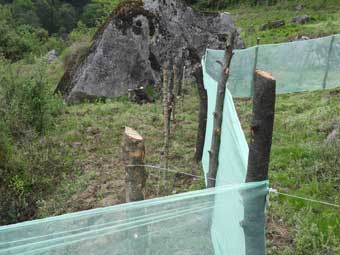[Kamal Medhi & Harshad Sambamurthy]
A changing landscape
I work with WWF-India, helping facilitate community-based conservation in Arunachal. The state is rich in biodiversity and home to many indigenous tribes. It is acknowledged to be one of the most splendid, variegated and multilingual tribal areas of the world with an estimated 106 tribal and sub-tribal groups.
Sixty percent of the state’s forested area falls outside reserved and protected area categories, and are considered as unclassed state forests (USF) and de facto remains under community custodianship, managed by the clans, traditional village institutions and individuals.
Tawang and its neighbouring district, West Kameng, are predominantly occupied by the Buddhist Monpa tribe, who sustain mostly on agriculture and livestock husbandry. Chiefly agro-pastoral, the community subsists on livestock husbandry and small-scale mountain agriculture, including rice at the low-lying valleys, barley, wheat, millet, maize and buckwheat, and meets local demands of food and other religious requirements.
In Tawang and West Kameng, large swathes of natural resources are managed by village institutions, such as the Mangma and the clans. Farm plots, however, are owned by individual households collectively. These fields are located in close proximity with the forests. Though there has been a transition to cash crops such as kiwi, apple and other horticulture products to meet emerging market demands, the pace and the involvement of the larger section of the community for commercial cultivation is slow. This is even more obvious in remote locations like the Zemithang valley, which is situated in the northwestern corner of Tawang district, and the majority of the people of the valley grow crops for their own consumption only.
Migration, however, is an emerging issue. Over the past decade, traditional agricultural practices, though serving as a lifeline, are witnessing a declining trend as people are pursuing work in road repairing and other construction sites for cash income. Many farmers are also giving up on agriculture, citing frequent crop depredation by wildlife.
Crop depredation
On field visits to Tawang, I often encountered a question: What is the solution to crop depredation by wild pigs?
I didn’t have a straight answer, nor could I provide a solution. Many villagers complain about crop depredation as the landholding for cultivation in the mountains are scanty and any form of crop loss leads to heavy economic damage for the marginal farmer.
In 2017, WWF-India conducted a rapid assessment to understand the challenges, nature of conflicts and people’s perception to delineate a strategy to deal with crop depredation. The assessment clearly indicated that the porcupine (Hystrix brachyuran) and the wild pig (Sus scrofa) are the two main species depredating crops at night, while the Arunachal macaque (Macaca munzala) and the barking deer (Muntiacus muntjak) were responsible for crop damage during the day. Most raided crops are millet, maize and potato.
During an initial conversation, the gaon burah of Lumpo, Nawang Chotta, said, “The situation was really bad as many of us even didn’t bother harvesting crops due to raids and we had to borrow seeds of maize, barley and millets from our neighbouring village of Muchut for this season’s cultivation (in 2018).”
The fencing solution

The team discussed these findings with the community and started a collaborative initiative to fence crops, initially using fishing net. This worked well at a few plots; however, fishing nets were not effective in preventing wild pigs from invading crops.
To resolve this, we added a single solar-powered wire with an energizer along with the fishing net at a height on par with the pig’s nose, roughly 40 cms above ground. The first such fence was piloted in Lumpo village of Zemithang valley. With small iterative steps made (ie, installation of a high-configured energizer and battery to withstand the harsh climatic condition at the height of 2000 mtrs), the first fence was installed in May 2018. Thus far, it has been working well, with minimal instances of human-wildlife conflict.

The efficacy of the fencing solution encouraged other villagers to revive their crop fields. The installed fence in Lumpo village now protects farm plots of approximately 40 families, and the communities have cultivated and successfully harvested wheat, millets and seasonal vegetables for at least two seasons now.
Successful implementation of the solar-powered fence in Lumpo village provides a ray of hope to many villagers in the Zemithang valley. Now the community reaches out to the district agriculture department, seeking support to cover more areas of cultivable lands. A similar model has been replicated by the Tawang district agriculture office in Khremu village, covering croplands belonging to more than 100 families.
According to the anchal samiti member of Khremu village, Sonam Tashi, “The fence has been working well since it was installed in August 2019, and it is effective to prevent wild pig and other wildlife from ravaging crops.”
“As the maintenance of the fence is the key to success, the village committee has decided to appoint two individuals to monitor functioning of the fence regularly and conduct repairs, if required. They are paid Rs 5000 each per month from the village treasury. We are hopeful that if we can secure a means of irrigation, some of us in the village would try to plant two crops next year instead of the one,” he added.
Strengthening community resilience
Government intervention and support for small and marginal farmers to promote mountain-based agricultural practices is imperative. The restoration of agriculture practices would help facilitate community self-reliance, reducing external dependence on resources, and help enhance community resilience and preparedness for any potential crisis or catastrophic situation like Covid-19 in the future, or during common seasonal occurrences like landslides that take place in the monsoon.
Securing farmlands through solar-fencing can bolster the agricultural production of a farmer, boosting confidence and halting migration in search of alternative livelihoods that may lead to additional pressures on biodiversity and food security. (Kamal Medhi and Harshad Sambamurthy are members of WWF-India.)


